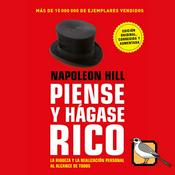Episodios disponibles
5 de 665
- Crafting Personal Havens: The Holistic Approach to Interior DesignWelcome, dear listeners, to another episode of "Interior Design for Beginners." Today, we are embarking on an explorative journey into the heart of interior design, uncovering an approach that intertwices your own story with the very fabric of your living spaces. This episode is titled "Crafting Personal Havens: The Holistic Approach to Interior Design." A personal haven is more than just a space filled with furniture and decor; it's a reflection of your journey, memories, and the essence of who you are. Creating a space that truly resonates with your personal narrative involves diving deeper into the elements that bring life to interior design. It's about looking beyond the aesthetics and understanding how each piece contributes to your overall well-being. A holistic approach to interior design prioritizes both the tangible and intangible elements - blending colors, textures, and lighting in a way that evokes emotions, memories, and comfort. Let's start with the cornerstone of any personal haven: comfort. A space cannot be truly yours if it does not bring you comfort. This goes beyond the physical comfort provided by plush sofas or ergonomic chairs. It's about creating environments where you feel safe, relaxed, and utterly at peace. Incorporating elements like soft lighting, warm color palettes, and cozy textiles can transform a mere room into a sanctuary. Next, we need to talk about stories. Yes, your stories. Incorporating personal artifacts, photos, and even art pieces you've collected over the years can add layers of depth and meaning to your space. These items are not just decorations; they are the narratives of your life, tangible memories that breathe life into the walls around you. Connectivity is another pivotal aspect. Your home should be a reflection of your life's journey, showcasing the connections you've made along the way. This can be achieved by creating visual flow between spaces, allowing each room to tell a part of your story while maintaining a cohesive narrative throughout your home. Now, let's not forget about nature. The philosophy of Biophilic design teaches us the importance of incorporating natural elements into our homes. Whether it's through the use of natural light, indoor plants, or materials like wood and stone, connecting with nature can significantly enhance our sense of well-being and create a more harmonious space. Lastly, let's discuss the power of reflection. Mirrors, both literal and figurative, can play a meaningful role in your interior design. They not only make spaces appear larger and brighter but also encourage self-reflection, a moment to pause and appreciate the journey that has led you to this very point in life. By adopting a holistic approach to interior design, you're not just arranging furniture or selecting paint colors; you're crafting a narrative, a personal haven that cradles your story and nurtures your soul. As we conclude this episode, I hope you feel inspired to look at your living spaces not as mere locations but as extensions of your journey, filled with love, memories, and the essence of you. Thank you for joining us on this transformative journey, and until next time, keep designing your personal haven. Brought to you by Room AI--------
- Unlocking the Symphony of Contrast: A Visual Concerto in Interior DesignWelcome to today’s episode of 'Interior Design for Beginners', where we embark on an auditory voyage through the enchanting realm of interior design. Today, we weave together a compelling narrative focused on one of the most captivating concepts in the design world: the Symphony of Contrast. It’s a journey that promises not only to enhance your understanding of interior design but to inspire you to view your spaces in a new light. Contrast in interior design does much more than create visual interest; it tells a story, evokes emotions, and establishes a dynamic atmosphere. Imagine, if you will, entering a room where every detail, from the colors to the textures and lighting, sings in a harmonious yet exciting dialogue. This is the essence of the Symphony of Contrast—a mesmerizing concert performed with visual elements. So, how do we master this visual concerto? Let’s start with color contrast, the most apparent form of contrast. Picture a room where stark white walls are the backdrop for a bold, black grand piano. The immediate impact of this high contrast not only draws your eye but also accentuates the elegance and form of the piano. But contrast isn’t just about opposites. It’s about balance. Introducing shades of gray can bridge the gap between black and white, creating a layer of sophistication. Moving beyond color, texture plays a pivotal role in crafting contrast. A velvet sofa against a wall of rough, exposed brick combines softness with ruggedness, inviting touch and creating a tactile experience that enriches the space. Lighting, too, can sculpt contrast. Imagine the interplay of shadows and light as sunlight streams through sheer curtains, dancing on surfaces, creating patterns that bring the room to life. But how do we ensure our concert doesn’t become cacophony? The key lies in repetition and rhythm. Just as in music, repeating contrasting elements at intervals creates a rhythm that guides the eye and ensures harmony. Pairing a sequence of smooth, round objects next to angular, textured ones across a space can establish a visual beat that enchants and guides. Contrast is not confined to visual elements alone. The juxtaposition of old and new brings a rich narrative to space, blending history with modernity. Imagine a contemporary leather chair beside an antique wooden table. This blend of epochs speaks volumes, inviting stories and sparking curiosity. Ultimately, the Symphony of Contrast is an invitation to play, experiment, and explore the vast possibilities of interior design. It encourages us to see spaces not just as rooms but as canvases for expression and creativity. As we conclude today’s episode, we hope we’ve sparked a flame of inspiration in your heart. Remember, in the concert of interior design, you are both the conductor and the composer. The magic lies in your hands. Thank you for tuning into 'Interior Design for Beginners'. We look forward to embarking on more design journeys with you. Until next time, may your spaces sing with the symphony of contrast. Brought to you by Room AI--------
- The Enigma of Scale: Transforming Your SpaceHello and welcome back to "Interior Design for Beginners", the podcast where we demystify the art of decorating your home, one enchanting episode at a time. Today, we’re unraveling a concept that’s as fundamental as it is fascinating: The Enigma of Scale: Transforming Your Space. Whether you’re living in a cozy studio or a spacious estate, understanding scale can significantly elevate your design game. So, let’s dive in. Imagine walking into a room where everything feels just right – the furniture isn’t overshadowing the space, and each decor piece seems to play its unique yet harmonious part in the room’s symphony. That balancing act? It’s all thanks to the thoughtful application of scale and proportion. Firstly, let’s clarify what we mean by ‘scale’ and ‘proportion’ in the realm of interior design. Scale refers to the size of objects relative to the space they occupy, while proportion relates to the size of objects in relation to each other. Getting these elements right is the secret to creating a room that not only looks good but feels right. A common pitfall in interior design is misjudging scale—opting for furniture that’s either too large, making a room feel crowded and claustrophobic, or too small, rendering the space sparse and uninviting. The key to avoiding this is to measure your space meticulously before shopping and to always bear in mind the scale of potential purchases. But it’s not just about size. The impact of scale comes down to the vibe you want to create. For a more intimate setting, smaller, cozier pieces can draw a room in, making vast spaces feel more gathered and inviting. Conversely, larger statement pieces can lend an air of grandeur and openness to a smaller room, provided they don’t overwhelm the space. Here’s a pro tip: use the magic of mirrors. Mirrors can cleverly manipulate the perception of scale by giving the illusion of depth, making your space appear larger. Moreover, paying attention to the placement of your furniture can also play a significant role in the effective application of scale. Creating zones within a room, for instance, can make a large open space feel more structured and cozy, without the need for physical dividers. To master the enigma of scale, observe and learn from different environments. Take notes of spaces that resonate with you and analyze how the scale of objects within those spaces contributes to the overall aesthetic and atmosphere. Inspiration can come from the most unexpected places. Before we wrap up, remember that scale isn’t just a rulebook to follow—it’s a tool to express yourself and to turn your space into a true reflection of who you are. Like any art form, it’s subjective. Trust your instincts, experiment with different scales and proportions, and most importantly, enjoy the process of creating a space that feels uniquely yours. Thank you for tuning in to today’s episode of "Interior Design for Beginners". We hope you’re inspired to play with scale in your own space. Remember, there’s no ‘one size fits all’ in design; it’s all about creating harmony and balance that speaks to you. Until next time, stay creative and confident in your design journey. Brought to you by Room AI--------
- The Symphony of Senses: Bringing Interior Design to LifeHello, dear listeners, and welcome to today’s journey through the enchanting world of interior design. We are about to embark on an exploration of a concept that’s as intriguing as it is essential - The Symphony of Senses. Join us, as we delve into how our senses play a pivotal role in crafting spaces that are not only visually stunning but also emotionally resonant and physically comforting. Interior design is not merely about the aesthetics; it's about creating an experience, a harmony that sings to every part of our being. As we walk through the door of a well-designed room, our senses are immediately engaged. The warmth or coolness of the air, the softness under our feet, the subtle hints of fragrance, the pleasing balance of light and shadows, and, of course, the visual feast for our eyes. Each element plays its part in the symphony of senses. Let’s start with the sense of sight, arguably the most talked-about in interior design. The colors, the textures, the balance of elements - all contribute to the visual harmony of a space. Colors especially have the power to evoke emotions; warm colors can create a feeling of coziness and energy, while cool colors can be calming and refreshing. The play of light and shadow further adds depth and dimension, making a room come alive. The sense of touch is just as crucial. Imagine running your hands over a smooth marble countertop or feeling the warmth of a woolen throw. These tactile experiences add a layer of comfort and luxury to your space, making it more inviting. Mixing materials and textures - soft fabrics with harder metals or woods - can create a balance that appeals to our inherent need for variety and contrast. Then there’s the sense of smell, often underrated in the context of interior design. Yet, think about how a particular scent can instantly transport you to a different place or time. Subtle fragrances from flowers, scented candles, or even a waft of fresh air can significantly influence the ambiance of a space, making it feel more welcoming and calming. Sound plays a vital role too. The gentle hum of a well-placed fan, the crackling of a fireplace, or the soothing background music can enhance the mood of a room. Even the choice of materials can affect sound - soft furnishings absorb noise, creating a quieter, more peaceful environment, while hard surfaces may echo, adding a sense of spaciousness. The sense of taste may not seem directly related to interior design, but it's all about the ambiance that makes dining in a particular space a more pleasurable experience. The visual presentation of a dining area, the comfort of sitting, the lighting - all contribute to how we enjoy our food. In essence, each decision made in designing a space affects not just how it looks but how it feels to be in it. By carefully considering the symphony of senses, designers can create spaces that truly resonate with us, providing not just shelter, but a sanctuary. So, the next time you step into a room, take a moment to appreciate the symphony of senses at play. How does the space make you feel? What emotions does it evoke? Interior design is a melody composed for our senses, a harmony that touches every part of our experience. And just like a symphony, when every element is in perfect harmony, the result is nothing short of magical. Thank you for tuning in to today’s episode on “The Symphony of Senses: Bringing Interior Design to Life.” We hope you leave inspired to consider your spaces in a new light, engaging all your senses to create a more harmonious, more beautiful home. Until next time, may your design endeavors sing a delightful tune. Brought to you by Room AI--------
- Whispers of Walls: The Art of Accents in Interior DesignHello and welcome back to another episode of "Interior Design for Beginners", where we delve into the fascinating world of creating beautiful spaces, one design element at a time. Today, we're focusing on something that might seem small but can have a mighty impact on how a room feels and looks: the art of accents in interior design. When we think of accent elements, we often think of vibrant throw pillows, striking vases, or eye-catching wall art. However, accents go beyond mere objects to include anything that adds character, focus, and depth to a space. They're the finishing touches that can transform an ordinary space into something extraordinary. Accent walls, for instance, can dramatically alter the perception of a room. Whether it's a bold color that contrasts sharply with the rest of the walls or a subtle texture that adds depth without overwhelming the senses, an accent wall can quickly become a room's focal point, drawing the eye and harmonizing with other decorative elements. But let's not stop at walls. Flooring can also serve as an accent. Imagine a room where the floors are a starkly different color or texture than the rest of the space. This bold choice can ground the room's design, providing a basis upon which to build a cohesive aesthetic. From patterned tiles to rich, dark wood, the options are endless and can dramatically shift how a space is perceived. Doorways and window frames can subtly act as accent pieces too. By painting them in a contrasting color or treating them with a unique finish, these often-overlooked elements can contribute to the room's overall narrative. They frame our view of the outside world or the next room with an artistic touch, adding layers to the story your space is telling. Let's not forget about the smaller, movable accent pieces. An eclectic mix of throw pillows, a strategically placed mirror, or a collection of artwork can all serve as accents that breathe life into a room. The key here is not just in selecting pieces that reflect your style but in placing them in a way that they create conversations with the other elements in the room. Harnessing the power of accents requires a careful balance. It's about creating focal points without clutter, adding personality without overwhelming the space, and harmonizing elements without making them feel too uniform. This delicate dance of design elements is what turns a house into a home, a room into a refuge. In the end, the art of accents in interior design is about storytelling. Your space should reflect your personality, your memories, and your dreams. Whether it's through a boldly painted wall, a carefully chosen throw pillow, or a unique piece of art, every accent tells a part of your story. So, embrace the whispers of the walls and let them speak in accents that resonate with the heartbeats of those who live within. Thank you for joining us on this journey through the magic of accents in interior design. Remember, in the world of design, every detail matters. Here's to creating spaces that speak to our souls. See you in the next episode! Brought to you by Room AI--------
Más podcasts de Arte
Podcasts a la moda de Arte
Acerca de Interior Design for Beginners
Spark your inner designer with daily insights on interior design, learning about trends, picking up practical tips, and getting inspired to transform your space.
Sitio web del podcastEscucha Interior Design for Beginners, PADRE RICO, PADRE POBRE AUDIOLIBRO y muchos más podcasts de todo el mundo con la aplicación de radio.net

Descarga la app gratuita: radio.net
- Añadir radios y podcasts a favoritos
- Transmisión por Wi-Fi y Bluetooth
- Carplay & Android Auto compatible
- Muchas otras funciones de la app
Descarga la app gratuita: radio.net
- Añadir radios y podcasts a favoritos
- Transmisión por Wi-Fi y Bluetooth
- Carplay & Android Auto compatible
- Muchas otras funciones de la app


Interior Design for Beginners
Escanea el código,
Descarga la app,
Escucha.
Descarga la app,
Escucha.





























